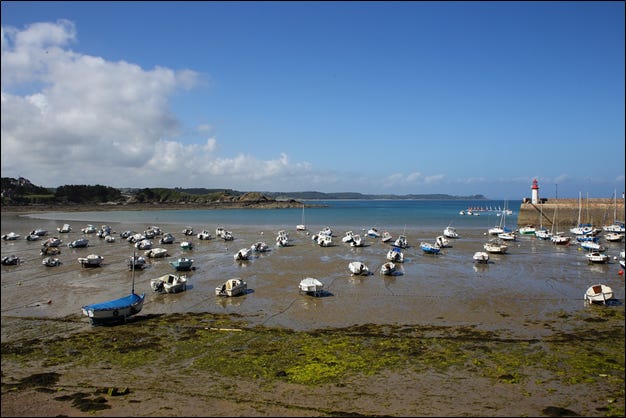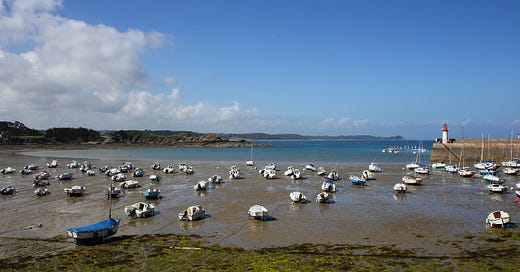Tung-yeh Chi was displaying his carriage driving before Duke Chuang. He drove back and forth as straight as a measuring line and wheeled to left and right as neat as a compass-drawn curve. Duke Chuang concluded that even Tsao Fu could do no better and ordered him to make a hundred circuits and then return to the palace. Yen Ho happened along at the moment and went in to see the duke. “Tung-yeh Chi’s horses are going to break down,” he said. The duke was silent and gave no answer. In a little while Tung-yeh Chi returned, his horses having in fact broken down. The duke asked Yen Ho, “How did you know that was going to happen?” Yen Ho said, “The strength of the horses was all gone, and still he was asking them to go on — that’s why I said they would break down.”
From Chapter 19, The Complete Works of Chuang Tzu, 1968, Burton Watson, Translator
Keeping up the Strength of Those Horses: The Hunter-Gatherer’s Meta-Solution to This Recurring Problem
Our hunter-gatherer ancestors lived on the 10:1 EROI/EROEI sweet spot between slight want and moderate abundance on the energy cliff. See the graph below, first shown and explained on this Substack here. If their local environment became depleted of foodstuffs and the energy return on hunting and gathering became uncomfortably low (threatening to take the hunter-gatherer band down into the dangerously hungry bottom of the energy cliff), the hunter-gatherer answer to the problem was always to move camp to a less resource-depleted terrain – and thus retreat a safe distance from the steeper, riskier slopes of the energy cliff.
Later, rather than follow their food like their hunter-gatherer forebears, farmers learned how to stay in place but had to be satisfied with a more precarious, chancier perch farther down along the side of the energy cliff. However, with episodes of associated global cooling and aridification, fuel wood exhaustion, soils depletion, salinization, or an unfavorable shift in political environment, even farmers sometimes had no choice but to pull stakes and change neighborhoods. Note, for example, that many of the 19th century Swedish farmers moved to North America when their previously stable but still risky position on the energy cliff (see above) began dropping out from under them because of forest depletion (Hall 2017):
There is relatively little quantitative information about actual EROIs for energy producing systems from the medium or distant past. Sundberg (1992) made a quite detailed assessment of the energy cost of energy in earlier Sweden. From 1560 until 1720 Sweden was the most powerful country in Northern Europe, based mostly on its very productive metal mines, but also an aggressive foreign policy backed up by high-quality metal weapons. The production of these mines required enormous amounts of energy for mining and especially smelting. The source of this energy was wood and especially charcoal (needed to get the high temperatures steel required) cut from Swedish forests. Sundberg gives a detailed calculation of how a typical forester and his family, self-sufficient on 2 ha of farmland, 8 ha of pastures and 40 ha of forest (collectively intercepting 1500 TJ of sunlight) generated some 760 GJ of charcoal in a year for the metal industry (equivalent in energy to 125 barrels of oil). To do that required about half a GJ of human energy or 3.5 GJ if we include the draft animal labor. So, we might calculate the EROI of the human investment to be as high as 1500:1, or some 220:1 if we include the animals. But that is just the direct energy, as it took 105 GJ to feed, warm, and support the forester and his family (which includes his replacement) and probably at least that to support the animals. So, if we include direct plus indirect energy the EROI is down to roughly 7:1. The system was sustainable as long as the forests were not overharvested. That was true until the middle of the nineteenth century, but then the forests were severely overharvested and many Swedes left for America [especially Minnesota].
Earlier, archeologically-defined examples of disturbed farmers, disturbed agriculture systems, and consequently disturbed dependent urban centers are listed in the series of Tables provided at the end of this post. The Tables concerned were taken from Denis Murphy’s People, Plants, and Genes (2007, Oxford University Press).
In each of the known past cases of farmer and farming disruption, at least some part of the disturbed farming population ended up following its inner hunter-gatherer and moved into a different geographical and/or technological terrain in order to persevere despite the changed outside conditions. These migrations left the urban centers dependent on the former agriculturalists adrift to some more or less serious degree.
According to Murphy’s (ibid.) compendium of archeological and recorded early human history, the worst case fate of any one complex urbanized society deserted by its farmers included:
Reduction in population – in population density if not in absolute number
of population members alive. This population reduction generally affects
farmer-dependent urban centers much more than it does the more dispersed,
yet more self-sufficient rural population
Reductions in governmental centralization and social and economic
complexity; e.g., loss of specialist classes, including “ruling elites”.
Desertion and ruin of the farmer-bereft urban center.
Possible long run loss or diminution of accumulated economic and
technological culture.1

However, It’s Not Just Locally-Disturbed Agriculture That’s Causing Us All the Problems This Time Around
As it has already been explained, the emergent problem affecting Western-style industrial civilizations and their urban centers is not the result of changes in climate or geomorphology on agriculture, but is instead global in geographic extent and global in economic effects. The fossil fuels tide of benefit to homo sapiens is actively receding, progressively leaving the fossil fuels-driven systems of modern, fossil fuels-dependent man stranded and mired, so to speak, on slowly drying and yet expanding economic mud flats.

The general global economic effect of this declining energy return of energy investment advancing since the first 1970 oil market shock is graphed below. Again, it’s not just a few farming regions and their associated urban centers containing “ruling elites” being shaken up and being inexorably shoved into disarray this time – it’s happening synchronously in all of the industrialized, human-occupied regions of the earth.

Yet another way of demonstrating that fossil fuels are indeed in ebb tide, and that this development of increasing energy cost of energy production is having penetrating global economic and other effects, is this graph also provided by Hall:

Observations
The following general observations of changes that have already taken place in the US (and elsewhere) in response to fossil fuels depletion are categorized following the thermodynamically-based structure of the Table below.

Continuing with the introduced ebb tide and mudflats metaphor, the human activities on the Table above can be visualized as a N-S map of a south-facing coast and beach, with high minimum EROI value activities like ‘arts and other’, ‘health care’, and ‘education’ representing upslope, high positions on the coastal beach, and categories like ‘support for family or workers’, ‘grow food’, ‘transportation’, ‘refine oil’, and ‘extract oil’, all on increasingly lower elevations of the same beach.
As global fossil fuels depletion started overtaking the compensatory fossil fuels discovery and development rates, the global average EROI for all fossil fuels began – just like an ocean tide – to start dropping in EROI value and started stressing and stranding, one by one, each human activity of relatively high minimum required EROI. Currently the global EROI of fossil fuels is at about 10:1, indicating that the arts, health care, and education categories of daily modern human life, with their relatively high minimum required EROI, should have by now suffered stress and begun evidencing dysfunction. In the US (and elsewhere), this is very definitely the case.
‘Support family or workers’ activities are also becoming increasingly stressed in the US, internally and externally. Internally, declining average real incomes in the face of continuing inflation have forced more and more US households to resort to, and default on, credit card debt. Externally, highly urbanized population centers (and their containing states) like Los Angeles, Chicago, and New York City are finding it more and more difficult to sustain and execute the services needed to maintain and support functional working households. The ongoing result of these negative developments in urban support of families and workers is discernible in recent population shifts away from those states that are having particular difficulty maintaining livable conditions in and around their metropolitan regions.

“Science Progresses One Funeral at a Time”
A new scientific truth does not triumph by convincing its opponents and making them see the light, but rather because its opponents eventually die and a new generation grows up that is familiar with it ...
An important scientific innovation rarely makes its way by gradually winning over and converting its opponents: it rarely happens that Saul becomes Paul. What does happen is that its opponents gradually die out, and that the growing generation is familiarized with the ideas from the beginning: another instance of the fact that the future lies with the youth.
— Max Planck, Scientific autobiography, 1950, p. 33, 97
A General Prediction
The same general human tendency that Max Planck identified as slowing down the progress of science is also hindering timely human adjustment to the globally increasing energy cost of energy and its crippling effect on human economic growth. Hall (ibid.), for example, points out that the continuing guiding influence of the dominant neoclassical economics growth theory on world business and government policy- and decision-makers is no longer a positive one because it basically assumes economic growth is a permanent given that can be maintained merely with judicious applications of labor, capital, and technology. Do you recognize anything critical missing in this dominant model of human economic reality?

The point being made here is that the top-down managers of large businesses and centralized governments have been suckled on, and are still suckling on, the magical thinking of neoclassical economic growth theory and – as of yet – have no ability to feed on more solid and now much more nourishing, ‘big-boy’ food. What this means for the people inhabiting Western-style industrialized economies is that until the present crop of business and government leaders gradually die off one by one, no great help with the fossil fuels depletion problem and its effects should be expected from ‘above’. Rather, individuals, families, and local communities will painstakingly have to work out solutions to the fossil fuels depletion problem for themselves.
The following series of Table pastes were copied from Denis J. Murphy’s People, Plants, and Genes, 2007. The information provided by Murphy illustrates that human civilizations based on agriculture have always been subject to exogenous disturbances. This being the case, the current fossil fuels depletion problem is just the latest (but largest?) example of a long series of like difficulties that humankind eventually worked its way through.
Mid-Palaeolithic to Neolithic/Chalcolithic chronology in the Near East, 250,000 to 5000 BP
Late Chalcolithic–Iron Age chronology in Mesopotamia, 5500 to 2000 BP
Chronology of the Indus Valley farming cultures, 9000 to 3000 BP
Chronology of early Chinese farming cultures, 10,000 to 2000 BP
Chronology of African farming cultures, 14,000 to 3800 BP
Chronology of European farming cultures, 40,000 to 1000 BP
Chronology of American farming cultures, 14,500 to 500 BP
This last negative consequence seems at least somewhat less likely in these times than it has been in the past, given the now very widely-disseminated and -recorded nature of accumulated human knowledge.


















